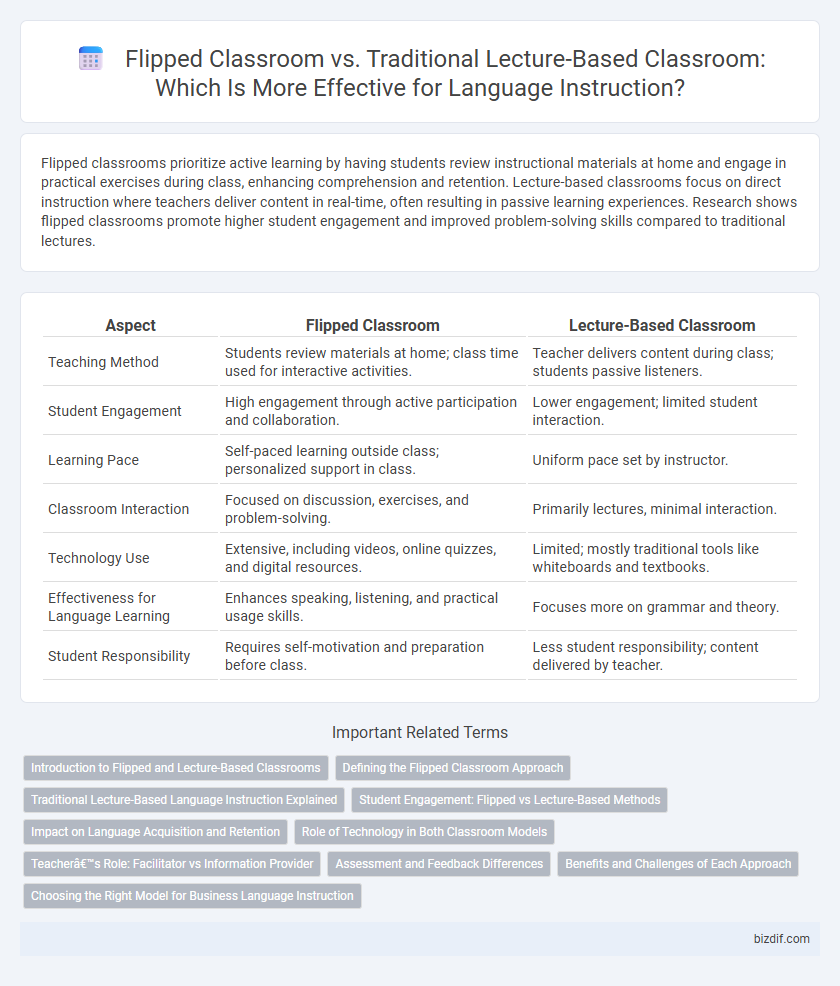Flipped classrooms prioritize active learning by having students review instructional materials at home and engage in practical exercises during class, enhancing comprehension and retention. Lecture-based classrooms focus on direct instruction where teachers deliver content in real-time, often resulting in passive learning experiences. Research shows flipped classrooms promote higher student engagement and improved problem-solving skills compared to traditional lectures.
Table of Comparison
| Aspect | Flipped Classroom | Lecture-Based Classroom |
|---|---|---|
| Teaching Method | Students review materials at home; class time used for interactive activities. | Teacher delivers content during class; students passive listeners. |
| Student Engagement | High engagement through active participation and collaboration. | Lower engagement; limited student interaction. |
| Learning Pace | Self-paced learning outside class; personalized support in class. | Uniform pace set by instructor. |
| Classroom Interaction | Focused on discussion, exercises, and problem-solving. | Primarily lectures, minimal interaction. |
| Technology Use | Extensive, including videos, online quizzes, and digital resources. | Limited; mostly traditional tools like whiteboards and textbooks. |
| Effectiveness for Language Learning | Enhances speaking, listening, and practical usage skills. | Focuses more on grammar and theory. |
| Student Responsibility | Requires self-motivation and preparation before class. | Less student responsibility; content delivered by teacher. |
Introduction to Flipped and Lecture-Based Classrooms
Flipped classrooms prioritize student-centered learning by delivering instructional content online before class, allowing in-class time for interactive activities and personalized guidance. Lecture-based classrooms follow a traditional model where the teacher presents information during class and students complete assignments independently afterward. Research shows flipped classrooms improve engagement and retention compared to passive lecture methods.
Defining the Flipped Classroom Approach
The flipped classroom approach reverses traditional teaching by delivering instructional content online outside of class, allowing in-person time for interactive activities and personalized guidance. This method emphasizes student-centered learning, promoting active engagement and deeper comprehension through collaborative exercises and real-time feedback. Research shows flipped classrooms improve language proficiency by facilitating practical application and immediate clarification of concepts.
Traditional Lecture-Based Language Instruction Explained
Traditional lecture-based language instruction centers on the teacher delivering content directly to students through lectures, emphasizing passive learning and memorization. This method often relies on repetitive drills and grammar explanations to reinforce language rules and vocabulary. While efficient for introducing new material to large groups, it may limit student interaction and personalized feedback critical for language acquisition.
Student Engagement: Flipped vs Lecture-Based Methods
Flipped classrooms significantly enhance student engagement by promoting active participation through pre-class materials and in-class discussions, contrasting with lecture-based classrooms that primarily rely on passive listening. Research shows students in flipped settings demonstrate higher motivation and deeper understanding, as interactive activities encourage critical thinking. In lecture-based environments, engagement tends to decline due to limited opportunities for immediate application and feedback.
Impact on Language Acquisition and Retention
The flipped classroom enhances language acquisition and retention by promoting active learning and increased student engagement through pre-class preparation and interactive in-class activities. In contrast, lecture-based classrooms often result in passive learning and lower retention rates due to limited opportunities for practice and immediate feedback. Research indicates that flipped classrooms significantly improve vocabulary retention, speaking fluency, and grammar comprehension compared to traditional lecture methods.
Role of Technology in Both Classroom Models
Technology integration in flipped classrooms enhances language learning by providing students with interactive digital resources and multimedia content accessible anytime, fostering personalized pace and active engagement. In lecture-based classrooms, technology primarily supports in-class presentations and passive content delivery, often limiting opportunities for individualized practice outside the classroom. Advanced platforms like learning management systems and language apps play a pivotal role in flipped models by enabling continuous assessment and feedback, whereas their use in traditional classrooms is more supplementary.
Teacher’s Role: Facilitator vs Information Provider
In flipped classrooms, the teacher acts as a facilitator, guiding students through active learning and promoting critical thinking by providing personalized support and encouraging collaboration. In contrast, lecture-based classrooms position the teacher primarily as an information provider, delivering content through direct instruction and maintaining control over the learning pace. This fundamental shift enhances student engagement and autonomy in flipped learning environments compared to traditional lecture settings.
Assessment and Feedback Differences
Flipped classrooms emphasize formative assessment through regular quizzes and peer feedback, enabling real-time adjustments to learning strategies and deeper student engagement. Lecture-based classrooms primarily rely on summative assessments like midterms and final exams, providing limited opportunities for immediate feedback and iterative learning. This shift in assessment dynamics fosters a more interactive and personalized language learning experience in flipped classroom models.
Benefits and Challenges of Each Approach
Flipped classrooms enhance student engagement and improve retention by allowing learners to review instructional content at their own pace before class, fostering active participation during in-person sessions. Lecture-based classrooms provide a structured environment for direct information delivery but often limit interactive learning and real-time feedback. Challenges of flipped classrooms include the need for student self-discipline and access to technology, while lecture-based methods may struggle with passive learning and reduced student motivation.
Choosing the Right Model for Business Language Instruction
Flipped classroom models enhance engagement and retention by promoting interactive, student-centered learning, making them ideal for business language instruction that prioritizes practical communication skills. Lecture-based classrooms efficiently deliver foundational grammar and vocabulary to large groups, offering structure for beginners needing systematic guidance. Selecting the right model depends on learner proficiency, class size, and instructional goals to maximize language acquisition and workplace application.
Flipped classroom vs lecture-based classroom Infographic

 bizdif.com
bizdif.com